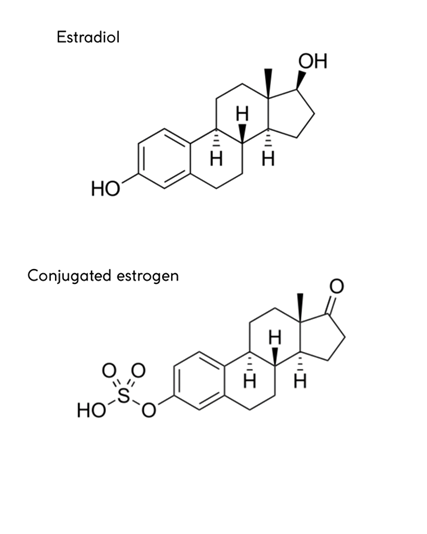Bio-identical hormones for HRT: what are they and do I need them?
- Dr Natalie Hutchins

- Mar 6
- 4 min read
Updated: Mar 7

A bioidentical hormone is one with the exact same chemical structure as the hormone that our body produces naturally.
Some of the first estrogens used for hormone replacement therapy were derived from the urine of pregnant horses. It was called Premarin (PRegnant MAre uRINe). This is naturally occurring source of oestrogen, but contains many types of oestrogen, the vast majority of which are not identical to ours.
The image below shows the chemical structure of estradiol and that of estrone sulphate, the most common type of conjugated oestrogen. You can see that although they look quite similar, they are not exactly the same.

Whilst evidence shows that conjugated estrogens are just as effective at managing hot flushes[1], most doctors now prescribe the newer versions of HRT containing estradiol. This estradiol is identical to the main oestrogen our body naturally produces (there are 4 types in total) and is a synthetic version of naturally derived estradiol found in plants. This is what is found in most available brands of hormone replacement therapy these days.
You may have also heard the term body identical hormones used and really for most prescribed versions of HRT, body identical and bioidentical can be used interchangeably. The reason the term body identical was coined, was really to try to differentiate it from the mainstream use of the term ‘bioidentical’, which refers to custom made (compounded) hormones made in a specialized pharmacy. We now use the terms regulated bioidentical HRT (rBHRT) and compounded bioidentical HRT (cBHRT) to avoid confusion.
What are compounded bioidentical hormones?
These are preparations of usually combined hormones, containing estradiol, progesterone and testosterone, that are made up in specialized pharmacies. The doses of hormone within the preparation are calculated based on serial hormone measurements, usually from salivary testing, to make the preparations ‘personalised’. The oestradiol in these preparations are also derived from plant sources and are bioidentical.
They became very popular after the results of the WHI study[2] were published at a time when conjugated estrogens were the most prescribed version of HRT. After the WHI, women and doctors became more fearful of conventional HRT due its side effects and compounded bioidentical hormones really took off.
So what is the issue with them in HRT?
Well, firstly, the scientific basis for serial hormone measurements and titrating the dose of hormones based on the result, is not sound. We know that during the perimenopause, hormones can fluctuate wildly from day to day, so a ‘personalised dose’ that appears appropriate on one day, may be completely different the next.
Secondly, normal oestrogen levels for a woman of reproductive age vary, so there is no standardised level that we should be aiming for; every woman is different.
And thirdly, testing hormones in the saliva is not an approved way of doing so and the results can be highly variable and innacurate.
For these reasons, prescribable hormone replacement therapy does not depend on blood results (although they may be tested using blood levels on occasion) but on how well your symptoms are being managed.
Is that the only reason they aren’t recommended?
No, apart from that, the main reason is one of safety. Unlike regulated body identical hormones, the clinical trials for compounded preparations are limited, of poor quality and interpretation of the results is complicated by the fact that these preparations vary so cannot be compared easily.
The contents[3], dose, quality, and sterility of these products are not subject to regulatory oversight. When they have been tested, potencies and patterns of absorption of have been found to be highly variable[4]. This could mean that quoted risks for things like breast and endometrial cancer are completely different to those for these compounded preparations and we don’t have any trial data to guide us on this.
So using them just doesn’t really make any sense from a safety perspective when we have regulated body identical hormones available. Conventional HRT is quality controlled, regulated and has clinical trials to prove it works and is derived from the same plant sources that the compounded versions are.
Not to mention, the compounded hormones are often much more expensive and may not be covered by medical insurance.
In summary:
- Most commercially available HRT preparations contain oestrogen that is bioidentical (exactly the same) as our own naturally occurring oestrogen
- These preparations are regulated and therefore have been tested for safety, quality, potency and their pharmacokinetic properties are standardised.
- The risks that we quote for HRT are based on data from these preparations and not the compounded variety
- Due to the varying contents, purity, potency and absorption of the compounded hormones, safety data that we have for conventional HRT may not apply to compounded hormones.
External resources
British Menopause Society consensus statement on bioidentical hormones: https://thebms.org.uk/publications/consensus-statements/bioidentical-hrt/
American College of obstetricians and gynaecologists statement on bioidentical hormones: https://www.acog.org/clinical/clinical-guidance/clinical-consensus/articles/2023/11/compounded-bioidentical-menopausal-hormone-therapy
[1] Nelson HD. Commonly used types of postmenopausal estrogen for treatment of hot flashes: scientific review. JAMA. 2004 Apr 7;291(13):1610-20. doi: 10.1001/jama.291.13.1610. PMID: 15069049.
[2] Writing Group for the Women's Health Initiative Investigators. Risks and Benefits of Estrogen Plus Progestin in Healthy Postmenopausal Women: Principal Results From the Women's Health Initiative Randomized Controlled Trial. JAMA. 2002;288(3):321–333. doi:10.1001/jama.288.3.321
[3] Pinkerton JV, Pickar JH. Update on medical and regulatory issues pertaining to compounded and FDA-approved drugs, including hormone therapy. Menopause. 2016 Feb;23(2):215-23. doi: 10.1097/GME.0000000000000523. PMID: 26418479; PMCID: PMC4927324.
[4] Sood R, Warndahl RA, Schroeder DR, Singh RJ, Rhodes DJ, Wahner-Roedler D, Bahn RS, Shuster LT. Bioidentical compounded hormones: a pharmacokinetic evaluation in a randomized clinical trial. Maturitas. 2013 Apr;74(4):375-82. doi: 10.1016/j.maturitas.2013.01.010. Epub 2013 Feb 4. PMID: 23384975.









